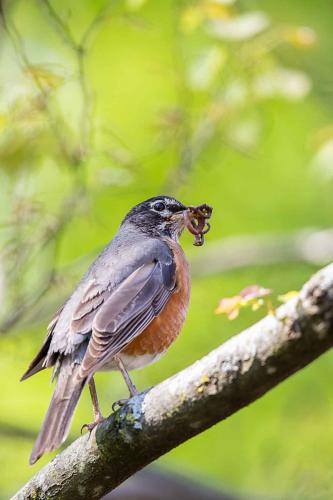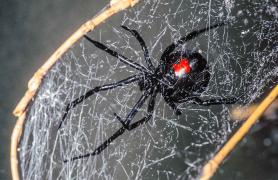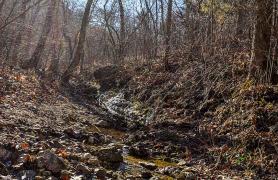
When I think of nature’s greatest joys and beauties, birds rank up at the top of my list — and I don’t think I’m alone. Think of the first time that you got a good look at an indigo bunting shining brilliantly neon in the sunlight, or a scissor-tailed flycatcher’s salmon-colored flanks, or a bald eagle diving down to pluck a fish from the water with its massive talons. Not to mention birds’ power of flight and mind-boggling migratory journeys of thousands of miles each year, for some that don’t weigh more than a penny!
Did you know that we’ve lost 29 percent of North American birds in the last 50 years? A 2019 study in the journal Science quantified the net loss in bird populations since 1970 and found a decline of 2.9 billion birds, or roughly one-third of our birds. And not just the rare ones. The hardest-hit and most steeply declining groups of species by habitat are grassland birds, which have shown a loss of 54 percent in the last five decades.
What has caused these declines? Many things, which is why it’s so difficult to slow. Large-scale land-use changes have removed or degraded much habitat. Regarding grassland birds, the agricultural landscape is very different than it was 50 years ago. We’ve lost a lot of timber, small fields, shrubby fencerows, and small fields used for habitat, or old fields scrubby with shrubs for nesting. Increased pesticide use has had an untold effect on the food source of all birds. Even if a bird is granivorous (only eats seeds), it’s feeding its young insects. Not to mention threats during migration and habitat removal on the wintering grounds for our migrant birds. The list goes on and on.
In the face of such declines, what can we do to help? Lots. There are small and large behaviors or actions we can all change today that will help us curb these declines, but we all must band together to make these changes at scale to really make a difference. Here are seven simple actions you can take for birds, today.
Grow Native Plants, Shrubs, and Trees
Native plants attract and sustain native insects and provide a perennial and long-lasting buffet for our birds right around your home with little to no maintenance. It’s a win-win for the birds and your water bill. Nonnative plants did not adapt to Missouri’s climate and conditions, so they hold little to no ecological value for native insects and therefore, do not provide the food that native birds need. Remember, even if birds are granivorous, they feed insects to their young. It takes 7,000–9,000 caterpillars to raise just one clutch of chickadees, so think how many insects are needed for all the birds nesting around you. Plant a variety of native plants, shrubs, and trees to attract birds to your yard or property. Learn more about bird-friendly natives at Missouri Prairie Foundation’s GrowNative! website grownative.org/learn/support-native-songbirds.
In terms of diversity and number, oak trees are the most productive native plant in the United States. Oaks host over 900 butterfly and moth species, which birds love to munch on.
Reduce Window Collisions
We’ve all seen or heard a bird crash into a window at our home or workplace. Think of how much glass is present on the landscape at our homes and urban centers. Those collisions add up. Birds see sky or vegetation reflected in the glass and think it’s a pass-through. Even if a bird revives and flies away after a collision, we don’t know how that affects their survival in the future, but it certainly can’t help. Collisions are the second-largest contributor to wild bird death, and it’s easy and cheap to prevent. Place opaque stickers on the exterior of your windows so birds see the pattern and know the window isn’t a passage. There are many stickers that don’t diminish your view out of the window, and it’s worth it to save bird lives over the long-term.
Drink Bird-Friendly Coffee
One-third of birds that breed in Missouri leave the U.S. for up to eight months of the year in the nonbreeding season during migration and winter. Most of the winter ranges of these migratory birds overlap with the Coffee Belt, or the world’s coffee-producing region generally located near the equator. So naturally, production of coffee and other agriculture has effects on “our” birds — or rather, our shared birds.
Just imagine billions of birds across Canada and the U.S. migrating south and piling into tropical forests, gorging on insects in a relatively narrow strip from Mexico through Central America, South America, and the Caribbean. You can see how the conservation of tropical habitats in these regions are essential, given that they sustain “our” Missouri breeding birds for over half the year, waiting for spring’s breeding-season insect abundance.
Deforestation, sometimes to make room for agricultural commodities like coffee grown in sun, is a major threat to migratory stop-over sites and wintering grounds. Bird-friendly coffee leaves a canopy of native trees over coffee shrubs to produce a higher-quality and better-tasting coffee grown in shade. This native tree canopy maintains foraging habitat for our migratory birds over top of the shade-grown coffee.
The Smithsonian Migratory Bird Center provides an online resource to find bird-friendly coffee near you: nationalzoo.si.edu/migratory-birds/where-buy-bird-friendly-coffee. Ask your local coffee shop to roast bird-friendly beans. Ask them if they know what bird-friendly is — if not, chat with them about it.
Reduce Pesticides
Remember that all our Missouri birds are insectivores for part of their life (except goldfinches, which feed their young exclusively seeds) and most feed their young insects. If you give your yard a pesticide bath, you’re removing that food source. Remember that native plants are best for insects and birds in your yard, but you don’t want to remove the insects — that’s the point.
Keep Cats Indoors
This is a tough, hot-button topic. People love birds and people love cats, but they often side with cats. It’s not a competition, but cats are the number one cause of wild-bird death on the landscape. But it’s not the cat’s fault. They are a natural predator, so it’s not surprising that they kill and eat billions of birds and other small wildlife annually. There are things we humans can do to help protect birds and give our cats an outdoor experience. They’re called catios, or enclosed outdoor patios for our cats. These enclosures keep our cats away from cars, disease, or potential predators — and it’s also safer for birds and other wildlife. For more information on catios, visit abcbirds.org/catio-solutions-cats.
Reduce Plastics
This one may surprise you. Even though we’re in a landlocked state, plastics still impact wildlife through litter, landfills, and eventually end up in our waterways and the ocean. Plastics take thousands of years to decompose. When you think about how many single-use plastics humans use in daily life multiplied by billions of us on the planet, it can be overwhelming. Many seabirds are impacted by plastics. Albatrosses and other seabirds are ingesting micro-plastics floating in the Pacific Ocean’s trash islands and feeding them to their young, thinking they look or smell like fish. Some of these birds naturally starve. Try to purchase multi-use plastics or glass products to minimize single-use or throw-away plastic products for long-term reduction of plastics on the landscape.
Record Your Bird Sightings
When you go birdwatching, report your bird sightings through eBird.org or contribute your bird ID knowledge to a breeding bird survey or Christmas Bird Count. The U.S. Geological Survey’s North American Breeding Bird Survey uses volunteers to count birds along survey routes once per year during the breeding season as a long-term measure of bird trends. Much of the data used for the Science article on bird declines was from this long-term survey that’s been conducted annually since 1966. eBird is a massive online database of birder sightings that has grown to such a size that it’s contributing to science and conservation. eBird has amassed one billion bird detections and it’s growing in popularity each year, largely through a smartphone app to log what you see outdoors. eBird users have reported so many detections on migration routes and wintering grounds that it’s allowing conservationists to protect migratory (and non-migratory) birds through their full annual cycle in targeted locations to be as efficient and effective as possible.
Conservation Works
Not all bird guilds are declining. Waterfowl is one of the only groups of birds that have increased over the last 50 years because conservation works. Due to targeted waterfowl and wetland conservation programs like Ducks Unlimited and the financial support of waterfowl hunters and federal wetland protection programs, wetlands are being protected and we are seeing the benefits. These are concerted, focused conservation efforts that we can learn from for other groups of species — and we must, or they will continue to decline, and we may begin to see extinctions of birds that used to be common.
What Can You Do to Help Birds?
We can change this trajectory for North American birds, but we need to act now. State and federal agencies and bird-conservation organizations are pulling together and scrambling to find ways to help birds at a large scale. But conservation groups can’t do it all. We are desperate for help at all levels — I urge you to find ways to help birds at some scale. It will make a difference. Switching to bird-friendly coffee and promoting it to your local coffee shops, friends, and family is a great start. Treating the exterior of your windows at home with decals to deter bird strikes and talking to friends and employers to do the same is another great step.
Taking these steps now to will help ensure we can continue to enjoy birds and future generations can be dazzled by the salmon-colored flanks of that scissor-tailed flycatcher, hear the plaintive whistle of a pewee, or enjoy the melodic chime of a meadowlark ringing across the field. There is something we can all do for birds right now — and we must.
- Birds eat 400–500 million tons of insects every year.
- Vultures eat dead carcasses and metabolize diseases like botulism and rabies. They eat disease and it doesn’t pass out the other end, preventing both wildlife and human health outbreaks.
- Birds disperse seeds to vegetate our world, and hummingbirds help pollinate many flowering plants. One blue jay can bury 4,500 acorns during a mast year to find later to eat. Luckily for oaks, they only remember the location of 1 in 4 of them, so they are oaks’ most efficient seed disperser.


















Also In This Issue

Beautiful spider with an ugly reputation.

Staff visit conservation areas and give their reviews.
And More...
This Issue's Staff
Editor - Angie Daly Morfeld
Associate Editor - Larry Archer
Photography Editor - Cliff White
Staff Writer - Kristie Hilgedick
Staff Writer - Joe Jerek
Staff Writer – Dianne Van Dien
Designer - Shawn Carey
Designer - Marci Porter
Photographer - Noppadol Paothong
Photographer - David Stonner
Circulation - Laura Scheuler






















